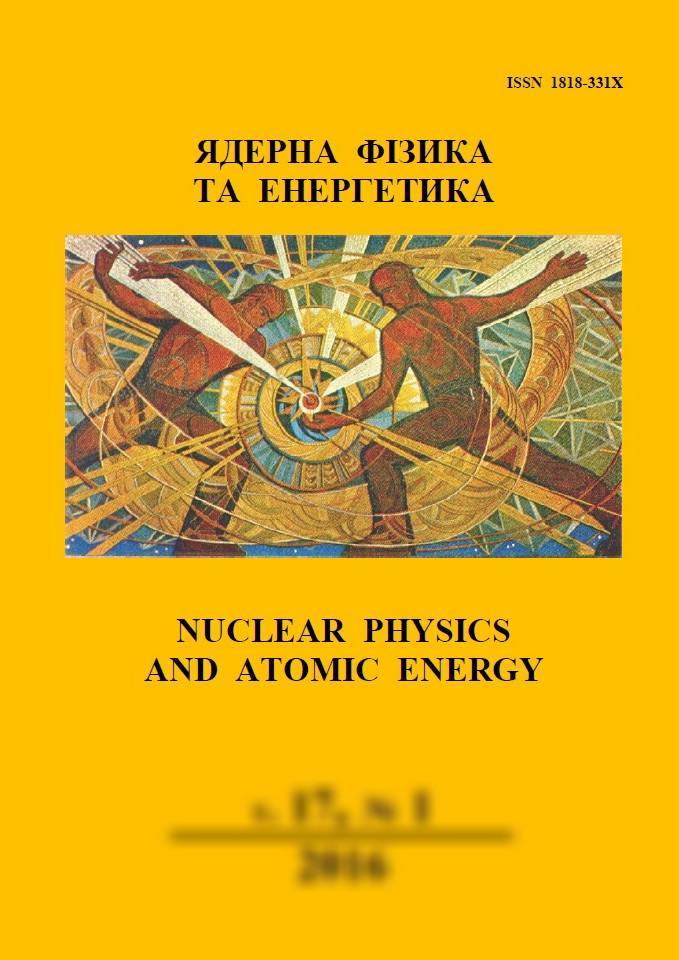 |
Ядерна фізика та енергетика
Nuclear Physics and Atomic Energy
ISSN:
1818-331X (Print), 2074-0565 (Online)
Publisher:
Institute for Nuclear Research of the National Academy of Sciences of Ukraine
Languages:
Ukrainian, English, Russian
Periodicity:
4 times per year
Open access peer reviewed journal
|
Nucl. Phys. At. Energy 2015, volume 16, issue 4, pages 337-342.
Section: Nuclear Physics.
Received: 28.09.2015; Accepted: 10.12.2015; Published online: 12.02.2016.
 Full text (en)
Full text (en)
https://doi.org/10.15407/jnpae2015.04.337
LEETECH facility as a flexible source of low energy electrons
D. Attie1, S. Barsuk2, O. Bezshyyko3, L. Burmistrov2, A. Chaus1, P. Colas1, O. Fedorchuk3, L. Golinka-Bezshyyko3,*, I. Kadenko3, V. Krylov2,3, V. Kubytskyi2, R. Lopez4, H. Monard2, V. Rodin3, M. Titov1, D. Tomassini4, A. Variola2
1 Commissariat a l’energie atomique, Institut de Recherche sur les lois Fondamentales de l'Univers (CEA IRFU), Saclay, France
2 Laboratoire de l'Accelerateur Lineaire (LAL, IN2P3/CNRS and Paris-Sud University), Orsay, France
3 Taras Shevchenko National University of Kyiv, Kyiv, Ukraine
4 CERN, Geneva, Switzerland
*Corresponding author. E-mail address:
lyalkagb@gmail.com
Abstract:
A new versatile facility LEETECH for detector R&D, tests and calibration is designed and constructed. It uses electrons produced by the photoinjector PHIL at LAL, Orsay and provides a powerful tool for wide range R&D studies of different detector concepts delivering “mono-chromatic” samples of low energy electrons with adjustable energy and intensity. Among other innovative instrumentation techniques, LEETECH will be used for testing various gaseous tracking detectors and studying new Micromegas/InGrid concept which has very promising characteristics of spatial resolution and can be a good candidate for particle tracking and identification. In this paper the importance and expected characteristics of such facility based on detailed simulation studies are addressed.
Keywords:
Micromegas/InGrid, PHIL photoinjector, gaseous tracking systems, Geant4, mono-chromatic electrons.
References:
1. M. Chefdeville et al. An electron-multiplying “Micromegas” grid made in silicon wafer post-processing technology. Nuclear Instruments and Methods A 556 (2006) 490.
https://doi.org/10.1016/j.nima.2005.11.065
2. R. Roux, S. Cavalier, M. Bernard et al. PHIL: a test beamline at LAL. Proceedings of EPAC08 (Genoa, Italy, 2008) p. 2698.
http://accelconf.web.cern.ch/AccelConf/e08/papers/wepp078.pdf
3. I-M. Gregor. Test beam for detector qualification in HEP. Talk at INFIERI2013 School (2013).
Talk
4. W. Matz et al. ROBL - a CRG Beamline for Radiochemistry and Materials Research at the ESRF. Journal of Synchrotron Radiation 6 (1999) 1076.
https://doi.org/10.1107/S0909049599010663
5. L. Quintieri et al. Photo-Neutron Source by High Energy Electrons on Target: Comparison between Monte Carlo Predicitons and Experimental Measurements. 2010 IEEE Nuclear Science Symposium Conference Record 31(1) (2010) 915.
https://doi.org/10.1109/NSSMIC.2010.5873895
6. B. Buonomo et al. A wide range electrons, photons, neutrons beam facility. Proc. of EPAC08 (Genoa, Italy, 2008) p. 3321.
http://accelconf.web.cern.ch/AccelConf/e08/papers/thpc143.pdf
7. S.M. Tajudin, Y. Namito, T. Sanami, H. Hirayama. Quasi-monoenergetic 200 keV photon field using a radioactive source with backscatter layout. Japanese Journal of Applied Physics 53(11) (2014) 116401.
https://doi.org/10.7567/JJAP.53.116401
8. S. Agostinelli et al. Geant4 - A Simulation Toolkit. Nuclear Instruments and Methods A 506 (2003) 250.
https://doi.org/10.1016/S0168-9002(03)01368-8
9. E. Gabriel et al. Open MPI: Goals, Concept, and Design of a Next Generation MPI Implementation. Proc. of the 11-th European PVM/MPI Users' Group Meeting (2004) p. 97.
https://doi.org/10.1007/978-3-540-30218-6_19
10. R. Brun, F. Rademakers. ROOT - An Object Oriented Data Analysis Framework. Nuclear Instruments and Methods. A 389 (1997) 81.
https://doi.org/10.1016/S0168-9002(97)00048-X
11. S. Barsuk et al. New Versatile Platform Based on the Low Energy Electron Beam Delivered by the PHIL Photoinjector. WDS'13 Proc. of Contributed Papers, Part 3 (2013) p. 33.
12. M. Mathes et al. Characterization of a Single Crystal Diamond Pixel Detector in a High Energy Particle Beam. Journal of Instrumentation 3 (2008) P12002.
https://doi.org/10.1088/1748-0221/3/12/P12002
